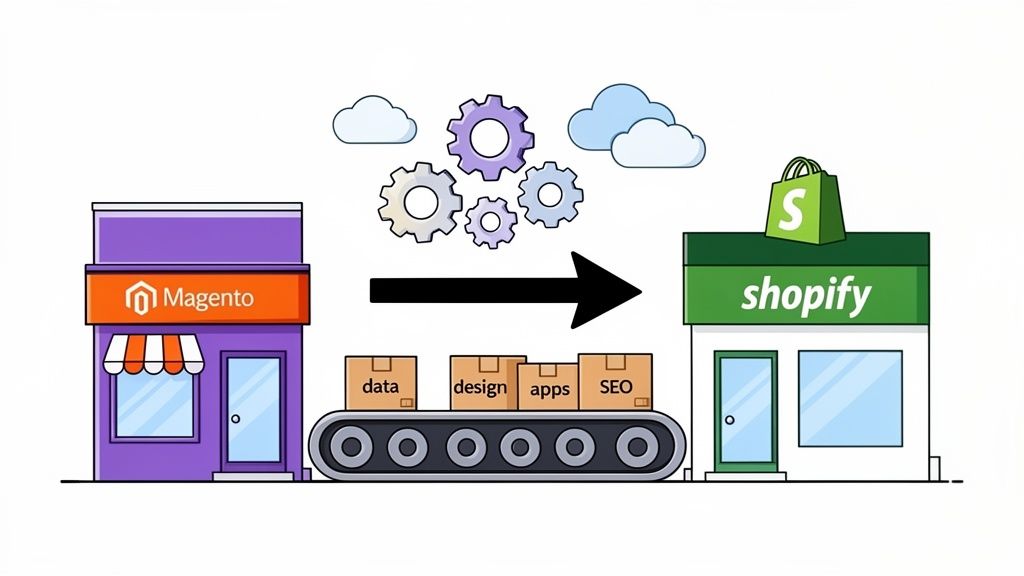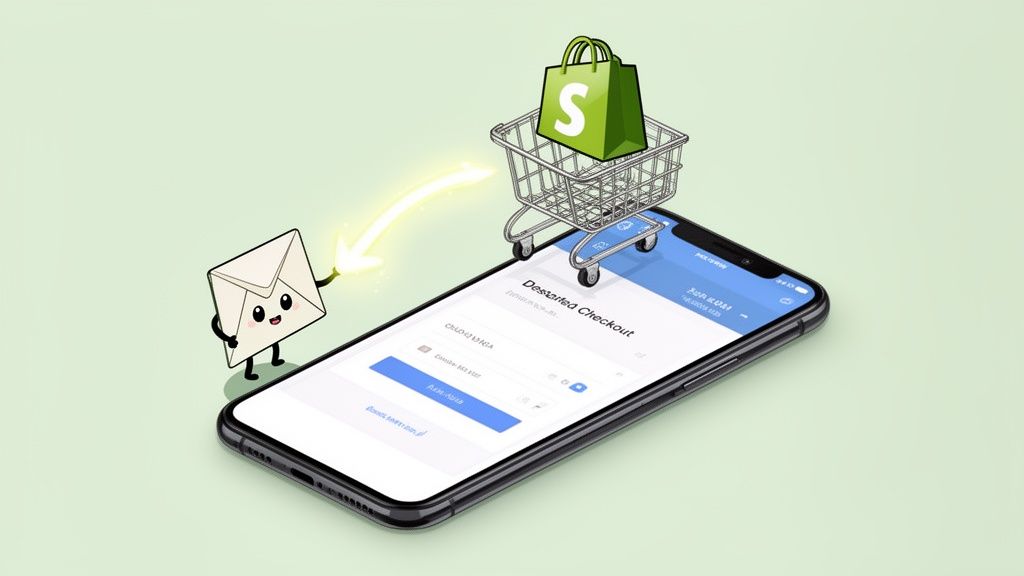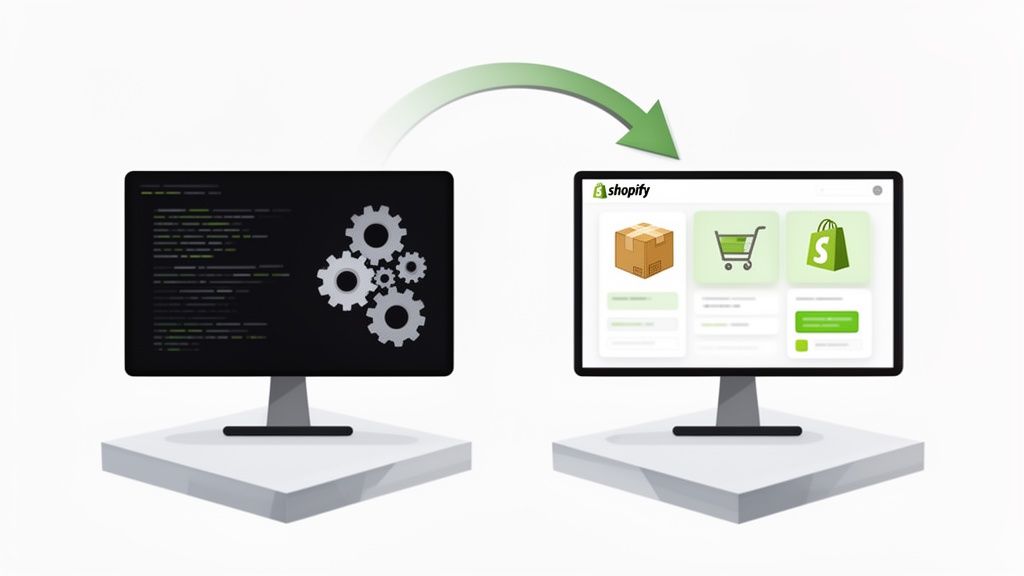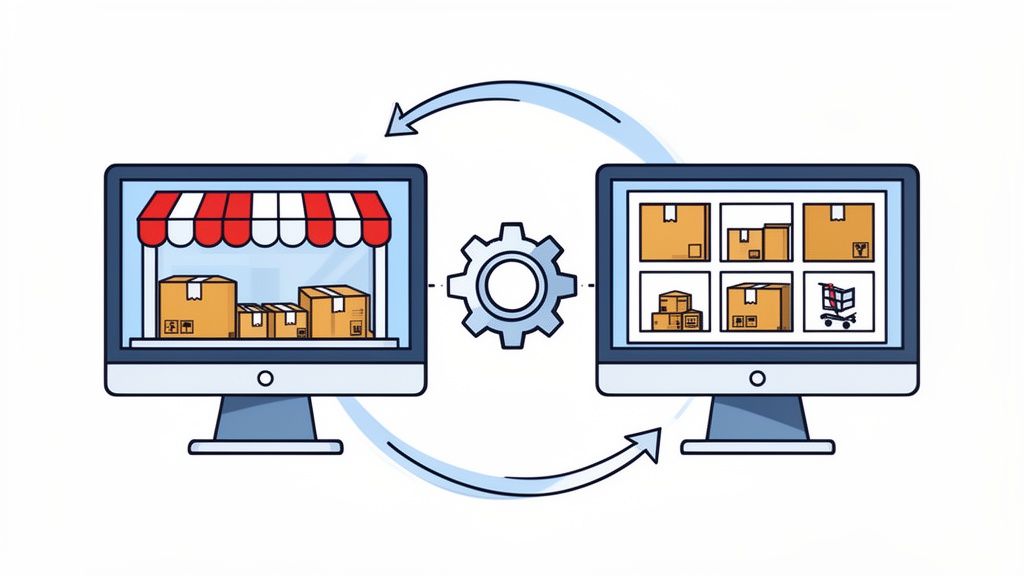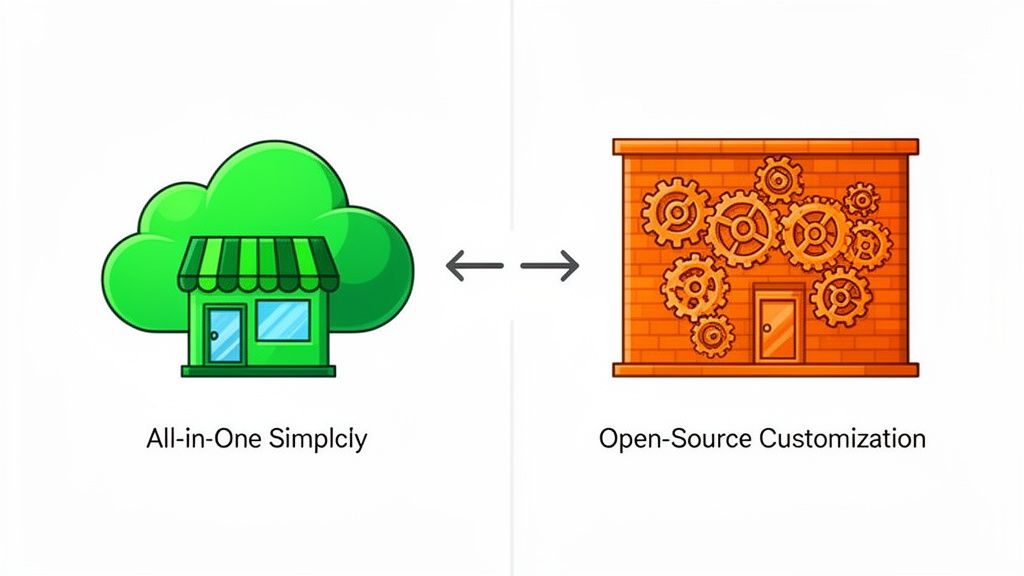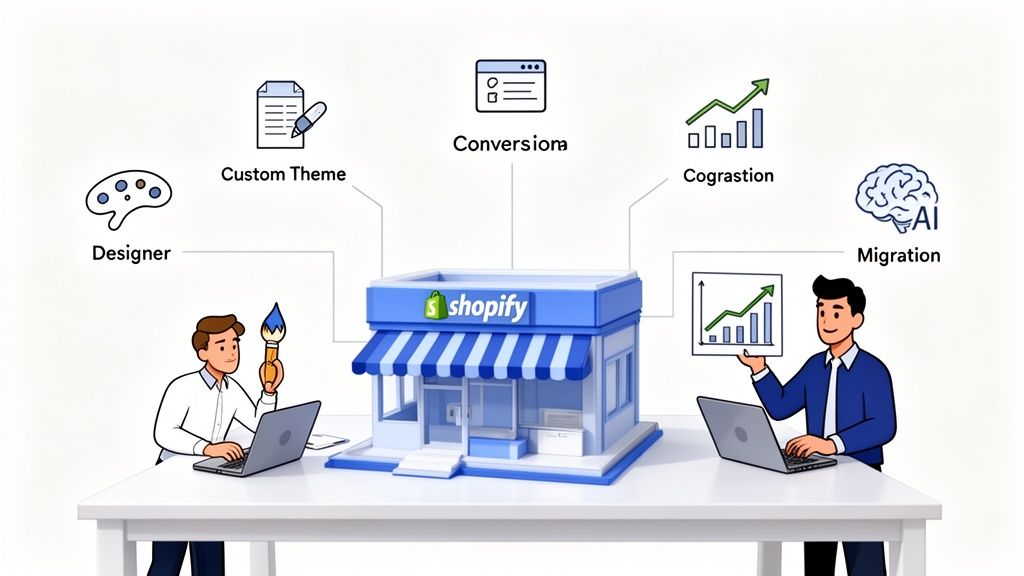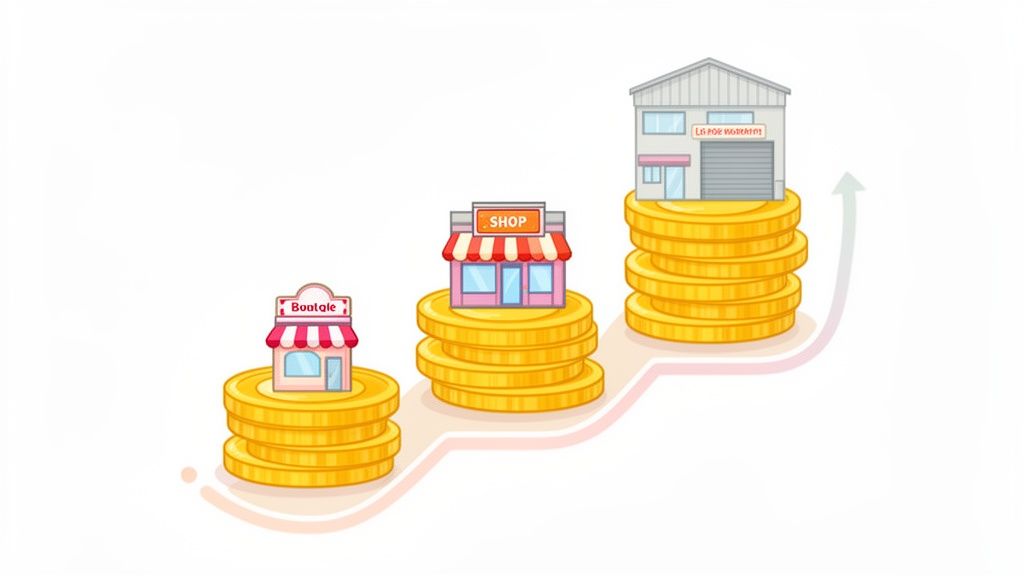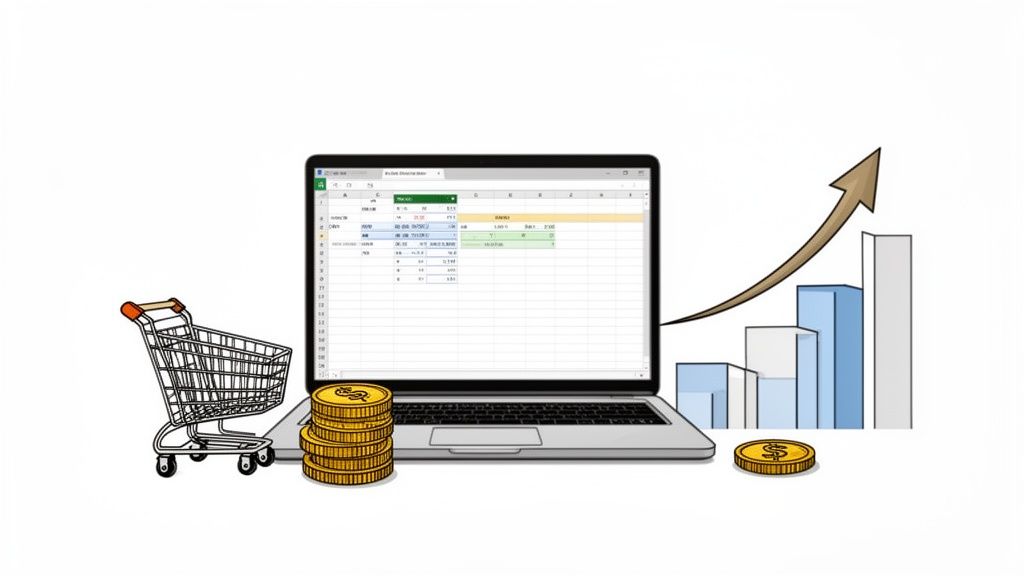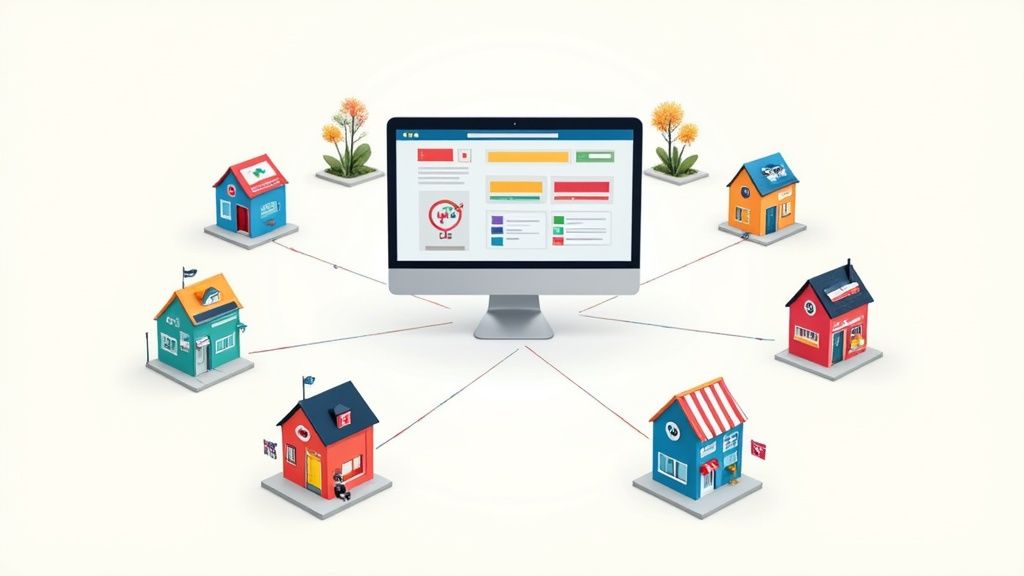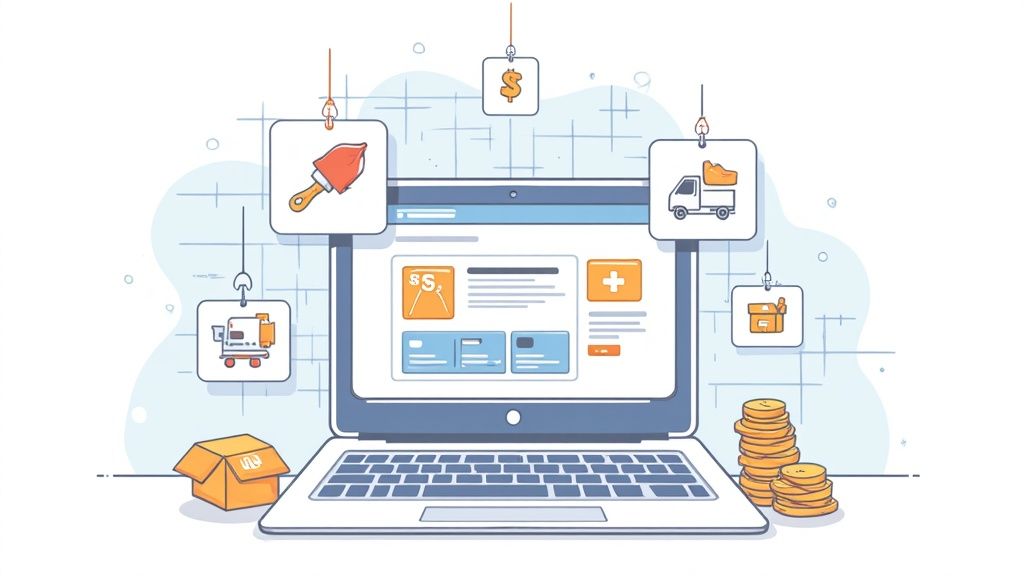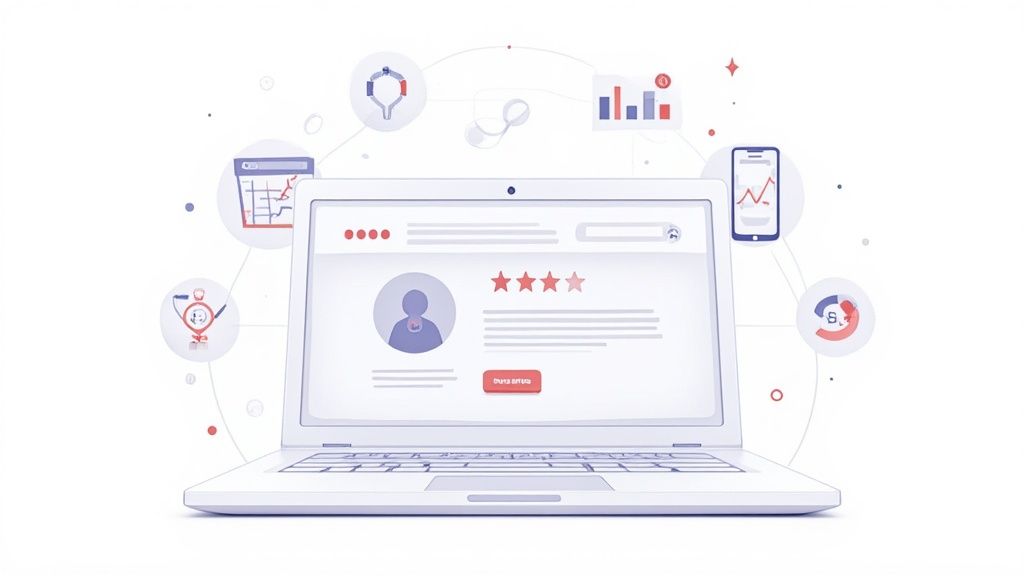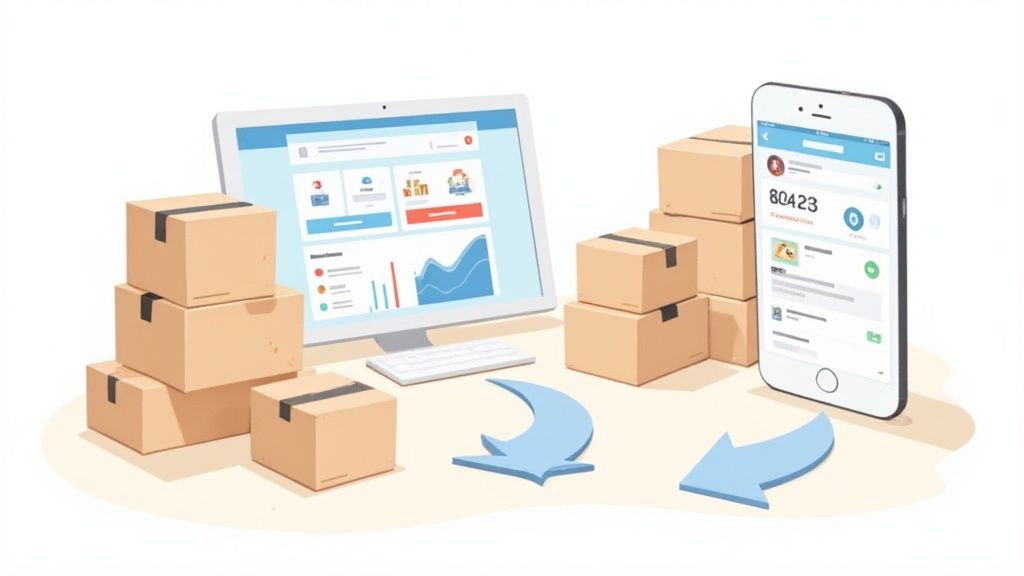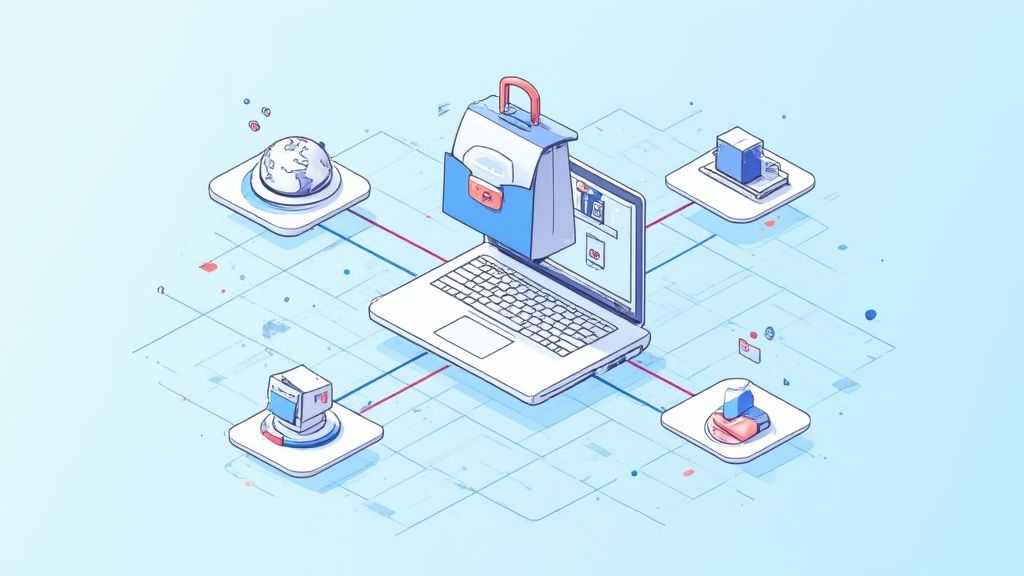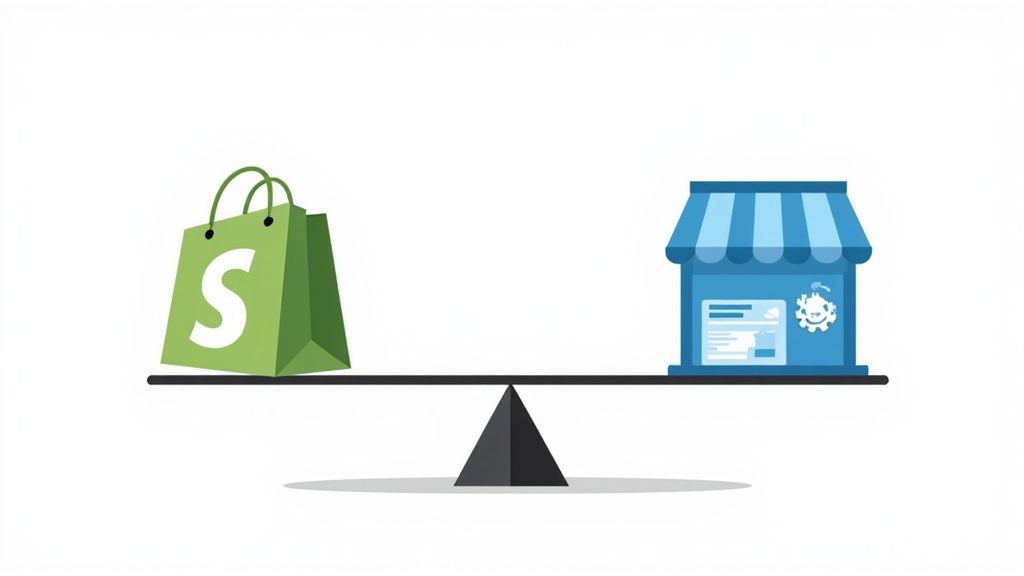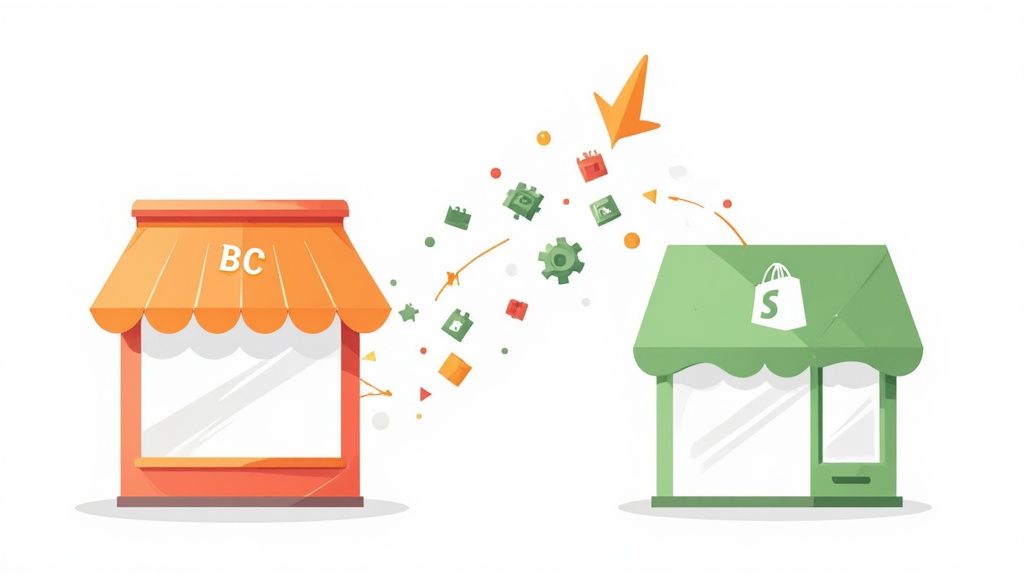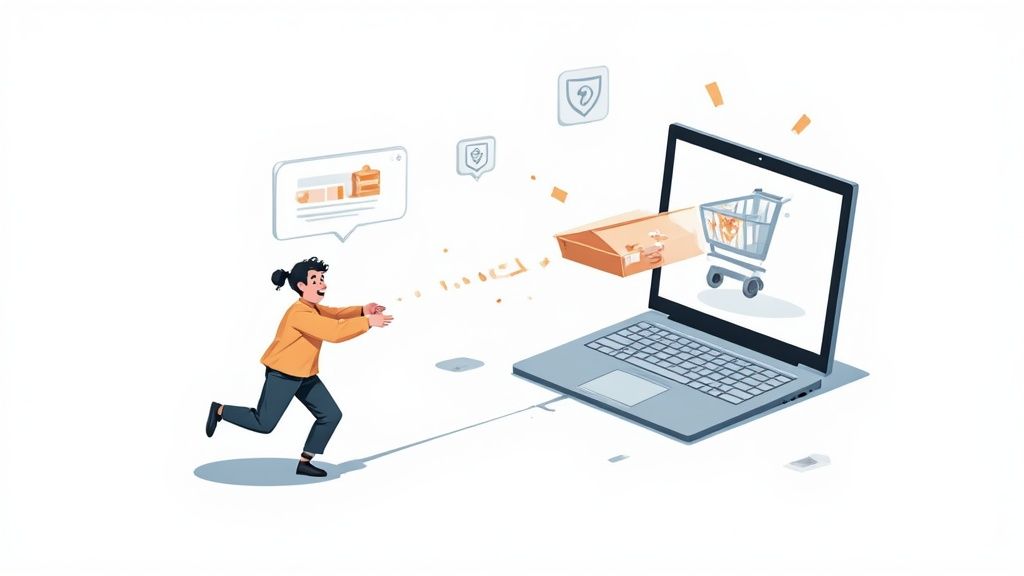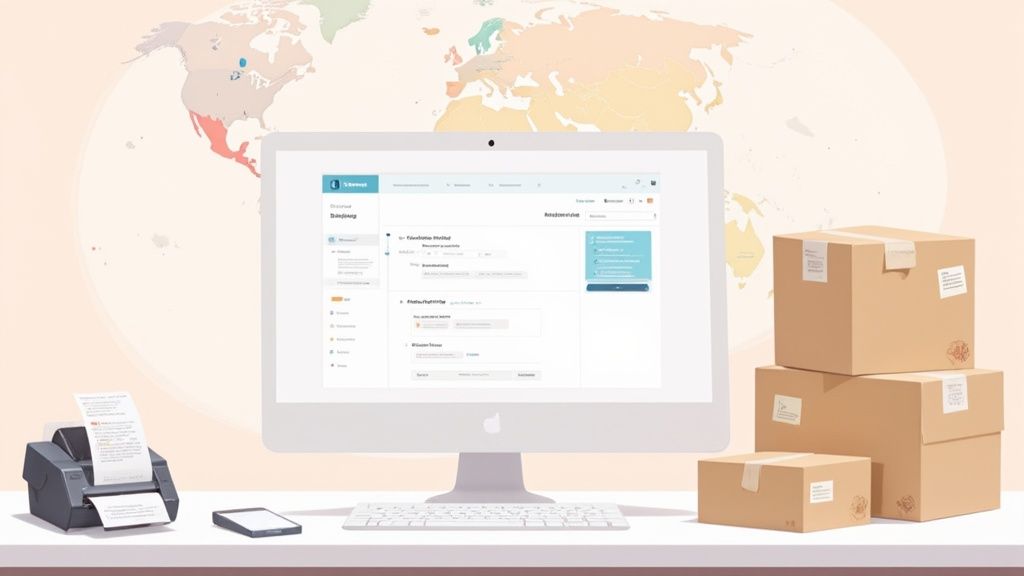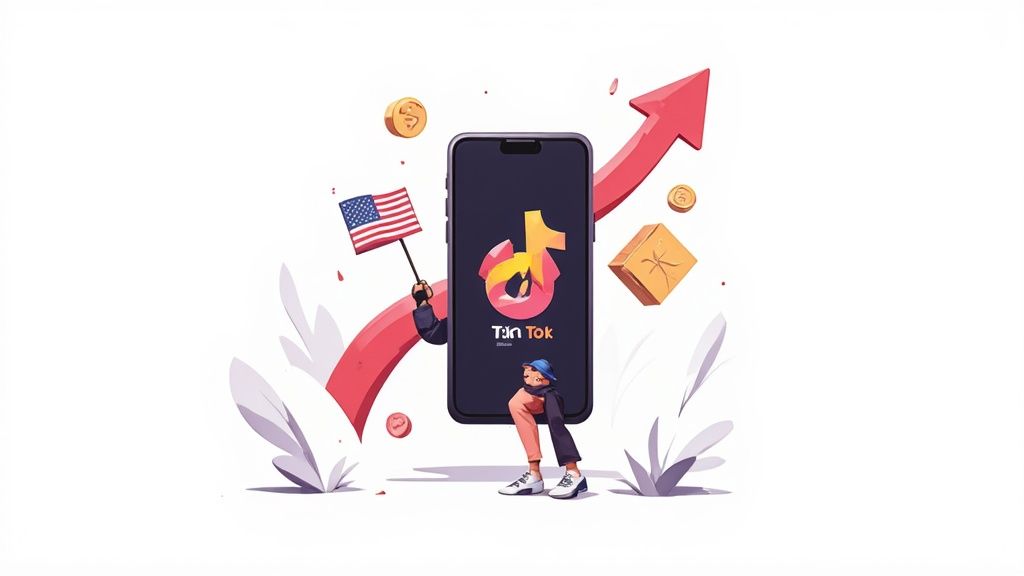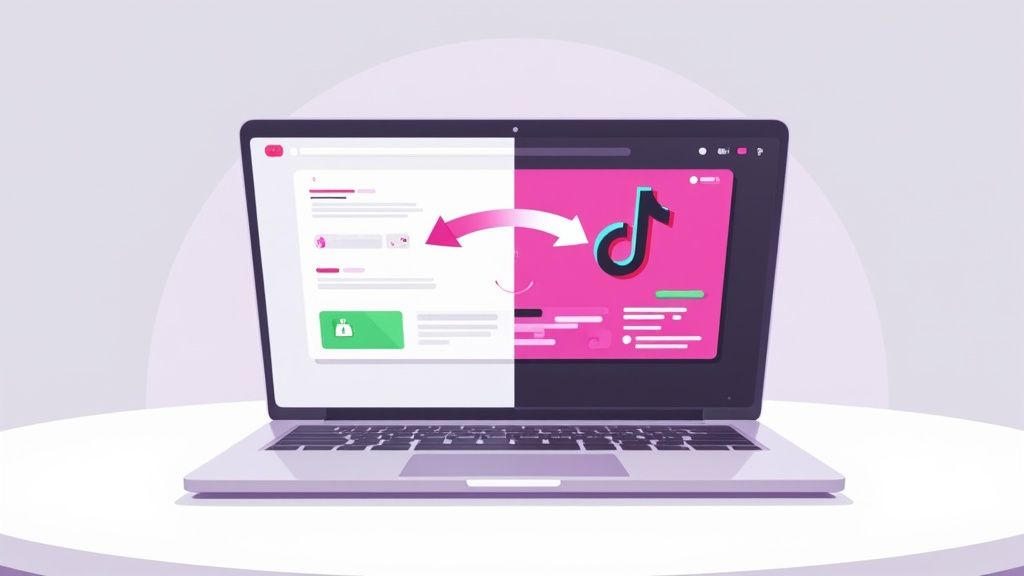
To really get a handle on preventing ecommerce fraud, you first have to understand just how damaging it can be to your business—financially and reputationally. It's so much more than just losing a product here and there. We're talking about a nasty combination of chargeback fees, brand erosion, and operational headaches that can quietly bring a growing business to its knees. A proactive, layered defense isn't just a good idea; it's essential for survival.
The True Cost of Ignoring Ecommerce Fraud

It’s easy to write off fraud as just another cost of doing business, a line item on the spreadsheet that you just have to accept. That perspective is dangerously outdated. In reality, unchecked fraud is a corrosive force that eats away at your profitability and customer trust from every direction. It’s never just about the direct loss of a stolen product; it's the cascade of hidden costs that really stings.
The financial fallout snowballs quickly. Every fraudulent order that slips through and becomes a chargeback doesn't just reverse the sale—it hits you with non-refundable processing fees and often, steep penalties from payment networks. Those fees add up fast, capable of turning what looked like a profitable month into a net loss.
A passive approach to fraud prevention is a recipe for failure in today's market. Ignoring the problem doesn't make it disappear; it just paints a giant target on your store for fraudsters.
A Snapshot of Common Ecommerce Fraud Schemes
Fraudsters are constantly evolving their tactics, but many of their methods fall into recognizable patterns. Understanding what these schemes look like is the first step in spotting them. Here’s a quick rundown of the most common types of fraud you're likely to encounter.
These are just a few examples, but they highlight how varied the threats can be. Each one requires a different detection strategy, reinforcing the need for a multi-layered defense.
The Staggering Global Impact
The scale of this problem is massive and it's growing at a frightening pace. Global e-commerce fraud losses have exploded, jumping from $41 billion in 2022 to an estimated over $48 billion in 2023. North America is getting hit the hardest, shouldering over 42% of these global losses, with Europe not far behind at 26%. This isn't just a statistical curiosity; it's a clear signal that every online merchant needs robust prevention measures. You can dig deeper into these global fraud trends and their impact on merchants to see the full picture.
And this isn't just a headache for the Amazons and Walmarts of the world. Small and medium-sized businesses are often prime targets precisely because they might lack sophisticated defense systems. For a growing brand trying to get a foothold, a string of fraudulent orders can be absolutely devastating.
Beyond the Balance Sheet
The damage isn't just financial. When a customer's account gets hacked or their card is used fraudulently at your store, their trust in your brand is shattered. That one negative experience can quickly turn into scathing reviews and negative word-of-mouth that scares away potential new customers.
On top of that, think about the time your team wastes dealing with the aftermath. They get bogged down investigating suspicious orders, compiling evidence for chargeback disputes, and trying to calm down frustrated customers. Every hour spent on fraud is an hour not spent on marketing, product development, or actually growing your business. This operational drag is a significant, yet often overlooked, cost of inaction.
Simply put, creating a proactive strategy to prevent ecommerce fraud is a direct investment in your brand's future and its success.
Understanding the Modern Fraudster's Playbook

To really prevent ecommerce fraud, you have to get inside the head of an attacker. Forget the cliché of a shadowy figure in a hoodie. The reality is far more calculated. We're talking about systematic, often automated, operations designed to poke holes in your store’s defenses. Their playbook is more business plan than random chaos.
Think of modern fraudsters as a business. They test, refine, and scale their methods to maximize profit and minimize their own risk. And who do they target? Often, it's growing stores like yours—stores that are laser-focused on making sales, not necessarily on plugging security gaps.
The scale of this underground economy is genuinely staggering. In 2023, ecommerce platforms lost an estimated $48 billion to fraud. A massive part of that comes from impersonation, which in 2024 accounted for a shocking 82% of all fraud cases in the ecommerce world. You can dig deeper into these trends in ecommerce fraud protection for 2025 to grasp the full scope of what you're up against.
The Anatomy of an Account Takeover
One of the most devastating attacks is the Account Takeover (ATO). This isn't just about a stolen password; it's a strategic hijacking of a loyal customer's entire identity on your site.
It usually kicks off with credentials bought from dark web marketplaces—lists harvested from huge data breaches that have nothing to do with your store. The fraudster then unleashes bots to systematically try these login combos across thousands of websites. It’s a brute-force technique called credential stuffing.
The moment they get a hit on your Shopify store, they're in. And they move fast.
- They’ll use saved credit cards to buy high-value items, shipping them to a reshipping address or mail drop.
- They’ll change the account's email and password, effectively locking the real customer out.
- They’ll even use the real customer’s order history to make their fraudulent purchases look legitimate and fly under the radar.
The fallout is a double-whammy. You’re out the product and hit with a chargeback. Even worse, you've just lost a loyal customer whose trust has been completely shattered.
Pro Tip: Keep an eye out for a storm of failed login attempts from a single IP address. This is a dead giveaway for a credential stuffing bot. Many security apps can automatically flag or block this kind of suspicious activity.
The Rise of Synthetic Identities
Fraudsters are also getting creative. Instead of just stealing an existing identity, they're building entirely new ones from scratch. This is called synthetic identity fraud, and it’s deviously clever.
They stitch together bits of real and fake information. For example, they might use a real Social Security number stolen from a child (who has no credit history to raise red flags) and combine it with a made-up name, address, and email. They might even create fake social media profiles to add a layer of legitimacy.
With this new "person," they can apply for credit, patiently build a "clean" history, and then launch a massive spending spree. For a merchant, these are incredibly hard to spot because individual data points might actually check out. The name is fake, but the shipping address is a real mail drop, and the credit card was technically issued to this synthetic person.
This is a long-game strategy. You're not dealing with a one-off attack but a sophisticated ring cultivating entire portfolios of fraudulent identities as assets.
Exploiting the Human Element
Beyond the tech, fraudsters are masters of social engineering, especially when it comes to "friendly fraud" and return abuse. They're banking on one thing: your customer service team is trained to make customers happy.
Here's how that playbook unfolds:
- The Claim: A fraudster places a perfectly normal order. Once it's delivered, they call their credit card company and claim the package never arrived or the charge was unauthorized.
- The Pressure: They know the burden of proof now falls on you. You have to scramble to collect delivery confirmations, AVS data, and communication logs. It's a time-consuming process that busy teams can't always afford.
- The Payoff: More often than not, the bank sides with its customer. The fraudster gets their money back and keeps the product. You lose the revenue, lose the inventory, and get slapped with a painful chargeback fee.
Return fraud is a similar story. A scammer might buy an expensive new jacket, then return their old, beat-up one in its place—or worse, a box filled with rocks. They're betting your warehouse team won't inspect every single return with a magnifying glass, especially during peak seasons.
By understanding these common plays, you can start seeing the potential weak points in your own operations. Every touchpoint, from login and checkout to your returns process, is a target. Recognizing the strategy behind the attack is the first real step toward building a defense that works.
Building Your Foundational Fraud Defense

Before you even think about complex apps and automated systems, the best way to prevent ecommerce fraud starts with a solid, manual review process. This is your first line of defense. It’s how you build an instinct for what a good order looks like—and what feels dangerously off. Luckily, Shopify gives you a powerful suite of native tools right out of the box.
The idea isn’t to put every single sale under a microscope. It’s about creating a simple workflow to flag and quickly investigate transactions that have red flags. This hands-on layer is surprisingly effective and costs you nothing more than a few minutes of your time. If you’re not on Shopify, these principles still hold true. For example, you can check out established BigCommerce security best practices to find similar built-in safeguards.
This initial, manual approach is critical. It grounds you in the real threats targeting your store, which makes any future tech investments much smarter and more effective.
Mastering Shopify's Built-in Fraud Analysis
When an order lands in your store, Shopify instantly runs it through hundreds of checks, giving you a color-coded summary: green for low risk, yellow for medium, and red for high. It's tempting to just cancel red orders and ship green ones, but the real power is in understanding why an order gets a certain rating.
The screenshot above is a perfect example of Shopify's fraud analysis in action, highlighting key indicators that need a closer look. Getting familiar with these details, like AVS checks and IP address data, is your first step toward making informed decisions instead of just guessing.
Think of this analysis as your investigation headquarters. Never take the color-coding as gospel. A "high risk" order could be a legitimate international customer struggling with their address format, while a "low risk" order might be a very slick fraudster. Your job is to connect the dots.
A manual review process isn't about becoming a detective for every sale. It's about creating a quick, efficient checklist for medium-risk orders so you can confidently approve or cancel them in minutes.
Key Indicators to Investigate
When a medium-risk (yellow) order pops up, don't panic. Just dig into the fraud analysis indicators. Here are the most important signals I always cross-reference:
- AVS (Address Verification System) Mismatch: This checks if the numbers in the billing address (street number and zip code) match what the card issuer has on file. A partial or full mismatch is a major red flag.
- CVV (Card Verification Value) Result: This confirms the 3- or 4-digit security code was entered correctly. If the CVV check fails, it's a strong sign the person placing the order doesn't have the physical card.
- Billing vs. Shipping Address: Do they match? If they don’t, is there a logical reason? An order with a US billing address shipping to a known freight forwarder in another country is a classic fraud pattern.
- IP Address Location: The IP address tells you where the order was placed from. If it’s in a completely different country than the billing address, you’ve got a problem.
- Email Domain: Does the email look real (e.g.,
john.smith@gmail.com) or like a disposable, randomly generated one (h7k9p2@tempmail.com)? Fraudsters love using throwaway emails.
One red flag on its own could just be a customer typo. But when you start seeing two or more of these on the same order—like a failed AVS check and an IP address from another continent—the chances of it being fraud skyrocket. This is exactly where your manual review pays for itself.
Putting It All Together
Let's walk through a real-world scenario. A $500 order comes in and Shopify flags it as medium risk. You check the details: the AVS shows a partial mismatch, the IP address is in a different state than the billing address, and the customer used a generic Hotmail account.
Instead of hitting cancel right away, you take two minutes to punch the shipping address into Google Maps. Turns out, it's a well-known freight forwarding company. The combination of these factors makes it almost certain this order is fraudulent. By canceling it, you just saved yourself the $500 product loss plus a potential $15 chargeback fee.
These small, consistent actions create a powerful shield around your business. Of course, this has to be paired with secure payment handling. For Shopify merchants, it’s a good idea to understand all the platform's security layers. You can learn more about how to maintain PCI compliance on Shopify in our essential guide, which perfectly complements your fraud review efforts.
Leveraging Technology for Smarter Fraud Prevention
As your store grows, that manual review process that worked so well in the beginning starts to feel like a serious bottleneck. What used to be a quick, five-minute check per order has snowballed into hours of tedious investigation. This is the exact moment when you need to switch gears—stop just reacting to fraud and start proactively outsmarting it. It’s time to bring in technology to do the heavy lifting, allowing you to prevent ecommerce fraud at scale.
This isn't about spending a fortune on some enterprise-level system. The Shopify App Store is packed with powerful, AI-driven tools built specifically for growing businesses like yours. These apps dig much deeper than basic checks, analyzing hundreds of data points in milliseconds to spit out a clear, actionable risk score. They are your secret weapon for automating your defenses and protecting your bottom line.
This infographic gives you a bird's-eye view of how different prevention methods stack up, really showing where technology shines.

The data makes it pretty clear: while manual reviews are a solid starting point, automated monitoring gives you a massive boost in effectiveness. It simply catches more fraud before it can do any real damage.
Key Features of Modern Fraud Prevention Tools
When you're shopping for a fraud prevention app, it's easy to get lost in all the marketing buzzwords. Let's cut through that noise and focus on the features that actually make a difference. These are the core technologies that separate a truly smart system from a basic one.
- Real-Time Risk Scoring: The system instantly analyzes every single order, assigning it a score based on hundreds of risk signals. This lets you set up rules to automatically approve low-risk orders and flag high-risk ones for a closer look.
- Behavioral Analytics: This is a real game-changer. The software watches how a user interacts with your site. Did they copy and paste the credit card number? Did they blast through checkout in under a minute? This behavior adds crucial context that simple data points just can't provide.
- Device Fingerprinting: Every device has a unique digital "fingerprint." This tech can spot if the same device is being used to place multiple orders with different credit cards—a classic red flag for fraud.
- Global Data Networks: The best tools are powered by shared data from thousands of other merchants. If a credit card was used in a fraudulent transaction on another store yesterday, the system will flag it on your store today.
These features all work in concert to build a complete picture of the transaction. It's the difference between looking at a grainy, black-and-white photo and watching a high-definition video of the entire customer journey.
Comparing Fraud Prevention Methods
Choosing the right approach all comes down to your store's current stage and specific needs. A brand new store just getting its first sales has a different risk profile—and different resources—than an established brand processing thousands of orders every day.
To help you figure out what makes sense for you, here’s a quick breakdown of the main fraud prevention methods.
For most growing Shopify stores, the sweet spot is a hybrid approach. You can use an AI-powered app to automatically handle the vast majority of your orders, while keeping a small manual review queue for those tricky "medium-risk" transactions that could use a human eye.
Choosing the Right Solution for Your Store
So, how do you pick the right app from the sea of options? Don't just look at the price tag. Your decision should be rooted in a few factors specific to your business.
First, consider your order volume and average order value (AOV). If you have a high AOV, the cost of a single fraudulent chargeback is massive, which makes a more robust prevention tool a very clear and sensible investment.
Next, think about your risk appetite. Are you in a high-risk industry like electronics or digital goods? These sectors are magnets for fraudsters, and a basic solution just won't cut it. A system with advanced features like device fingerprinting becomes non-negotiable.
Finally, consider integration and workflow. The best tool is one your team will actually use without friction. Look for solutions that integrate cleanly into your Shopify dashboard and let you create simple, automated workflows—for instance, "If an order's risk score is above 85, automatically cancel and refund."
The goal isn't to build an impenetrable fortress that blocks everyone. The goal is to create a smart, flexible system that stops bad actors while providing a smooth, frictionless experience for your legitimate customers. Investing in the right technology makes that balance possible.
Winning the Battle Against Chargebacks
Chargebacks are one of the most painful parts of running an online store. They’re far more than just reversed sales; they're a direct hit to your revenue, bringing frustrating fees and administrative headaches along for the ride.
Winning this fight requires a two-pronged attack: one for actively disputing chargebacks and another, more crucial strategy, for preventing them from happening in the first place.
The financial stakes are staggering. Chargebacks are an incredibly costly form of ecommerce fraud, with global losses projected to hit $33.79 billion in 2025 and climb to an eye-watering $41.69 billion by 2028. It gets worse. For every dollar lost to fraud, U.S. merchants actually lose about $4.61 when you factor in all the associated costs.
A huge slice of this pie is “friendly fraud,” where legitimate customers dispute valid charges. This accounts for roughly 75% of all cases. If you want to dive deeper into the numbers, these chargeback statistics and trends from Chargeflow paint a pretty stark picture.
Effectively managing chargebacks means understanding that not all disputes are created equal. You have to learn the difference between malicious fraud and customer-driven issues.
Distinguishing Between Malicious and Friendly Fraud
The first step in any battle is to know your enemy. A chargeback from a stolen credit card is fundamentally different from one started by a confused customer, and your response needs to reflect that.
- Malicious Fraud Chargebacks: This is straight-up criminal activity. A fraudster used stolen payment details to make a purchase. Your goal here is to prove to the bank that you did your due diligence by using fraud detection tools like AVS (Address Verification System) and CVV checks.
- Friendly Fraud Chargebacks: This is when a real customer disputes a real purchase. The reasons are all over the map—they might not recognize the charge on their statement, forgot they bought something, or are just feeling a bit of buyer's remorse. This is where excellent customer service and crystal-clear communication are your best weapons.
Getting this distinction right is everything. Treating friendly fraud like a crime will only alienate a real customer. On the flip side, treating malicious fraud like a simple misunderstanding will lose you the dispute every single time.
Building a strong defense isn't just about winning disputes—it's about creating a system where fewer disputes happen in the first place. Proactive prevention is always more effective and less costly than reactive fighting.
Assembling Compelling Evidence for Disputes
The moment a chargeback hits, the clock starts ticking. You have a very limited window to submit your rebuttal package to the customer's bank. A disorganized, weak response is an almost guaranteed loss. Your mission is to paint a clear, undeniable picture that the transaction was legitimate and you held up your end of the bargain.
Think of your evidence file as a comprehensive case that leaves no room for doubt.
- Transaction and Order Details: Start with the basics: customer's name, email, the last four digits of the card, and the order date.
- Fraud Analysis Data: This is your technical proof. Provide screenshots of your Shopify fraud analysis or data from your prevention app. You need to highlight matching AVS and CVV results and show that the IP address location lines up with the billing address.
- Customer Communications: Dig up any emails, chat logs, or support tickets related to the order. This is incredibly powerful if the customer contacted you about the product before claiming the charge was fraudulent. It shows they were engaged and aware of the purchase.
- Delivery Confirmation: This is absolutely non-negotiable. You need definitive proof of delivery from the shipping carrier that clearly shows the tracking number and the delivery address—the same one provided in the order.
Organize all this information into a clean, easy-to-read document. Remember, the people reviewing these see thousands of them. Making your case clear and concise dramatically improves your odds of winning.
Proactive Tactics to Stop Disputes Before They Start
Winning disputes is good. Preventing them is far, far better. A huge number of chargebacks, especially the friendly fraud variety, can be stopped dead in their tracks with simple, proactive measures that improve clarity and the overall customer experience.
A fantastic place to start is your billing descriptor. This is the little line of text that shows up on a customer’s credit card statement. If it’s something cryptic like "SP *MERCHANT123" instead of your store's name, customers won't recognize it and will immediately assume it’s fraud. Make sure your descriptor is unmistakable.
Next, tighten up your policies and communication.
- Make Your Return Policy Obvious: If a customer can’t easily find your return policy, they're much more likely to just file a chargeback. Plaster links to it in your site footer, on product pages, and in order confirmation emails. Don't make them hunt for it.
- Send Shipping Updates: Be proactive with communication. Email customers with tracking information as soon as it's available. This reassures them their order is on its way and creates a helpful paper trail.
- Offer Stellar Customer Service: Make it dead simple for customers to contact you with questions. A prominent "Contact Us" page with a phone number, email, or live chat can resolve an issue that might have otherwise snowballed into a chargeback.
By putting these strategies into play, you can slash the number of disputes you have to deal with, saving you time, money, and protecting your valuable customer relationships.
Your Questions on Ecommerce Fraud Answered
Running an online store means dealing with the constant threat of fraud. It's a tricky balancing act—you want to lock down your business, but you can’t afford to scare away real customers or create a clunky checkout experience. It’s a common place for merchants to feel stuck.
So, let's clear things up. Below, I’ll walk you through the most frequent questions we get from store owners who are ready to get serious about fraud prevention. The goal is to give you practical, no-nonsense answers so you can move forward with confidence.
How Much Should My Store Spend on Fraud Prevention?
There's no one-size-fits-all answer here. The right budget really depends on your store's specific situation—your revenue, average order value (AOV), and most importantly, what you're actually losing to fraud right now.
A smart way to start is by calculating your current monthly losses from chargebacks and confirmed fraud. Your prevention spending should be a fraction of that amount. The math is simple: spend less on tools than you save by stopping bad orders.
If you’re just starting out, Shopify's built-in fraud analysis is often more than enough to get you by without spending an extra dime. As you grow and your order volume picks up, that’s when investing in a specialized app becomes a no-brainer with a great ROI.
Will Strong Fraud Filters Block Good Customers?
This is a huge and completely valid concern. We call these "false positives," and yes, if your fraud rules are too aggressive, you can absolutely alienate legitimate customers. That’s the last thing anyone wants.
The trick is to find the right balance. Modern fraud tools don't just use crude rules like "block all orders from Country X." Instead, they rely on AI to analyze hundreds of different data points, giving you a much more nuanced risk score. It’s far more accurate than just flagging big-ticket orders or all international customers.
A great strategy combines smart automation with a quick manual review for any "medium-risk" orders. This lets you instantly block the obvious fraudsters while making sure you don't accidentally reject a great customer just because their shipping and billing addresses don't match.
This balanced approach keeps the checkout flow smooth for the vast majority of your real customers while giving you a solid layer of security. It’s all about working smarter, not harder.
Is Friendly Fraud Really a Big Deal?
Oh, absolutely. Friendly fraud—when a real customer disputes a legitimate charge—is a massive headache. It can account for up to 75% of all chargebacks, making it one of the biggest silent profit killers for online stores.
Most of the time, it's not malicious. It’s usually caused by simple confusion. Maybe the customer doesn’t recognize your store's name on their credit card statement, or their kid used their card to buy something without asking. A classic case of buyer's remorse can also be a trigger.
Since the intent is different, your strategy for fighting it needs to be different, too. This isn't about catching a thief; it's about clear communication to prevent misunderstandings before they happen.
Here’s how you can get ahead of friendly fraud:
- Use a Recognizable Billing Descriptor: Make sure the name on your customers' credit card statements is clearly your store name. A cryptic name like "SP*WEBSERVICES" is a guaranteed recipe for confused chargebacks.
- Make Policies Easy to Find: Your return and refund policies should be linked clearly in your website footer and all order-related emails. Don't make people dig for them.
- Be Proactive with Communication: Send crystal-clear order and shipping confirmation emails. In fact, improving your overall communication is key. You can learn more about how to do this effectively in our detailed guide to email marketing in ecommerce.
These small, customer-centric tweaks can stop a simple misunderstanding from escalating into a costly chargeback.
Can I Ever Get My Fraud Rate to Zero?
While a zero-fraud business sounds like the dream, it's just not realistic. Fraudsters are always changing their tactics, and there will always be a new scam around the corner.
The real goal isn't total elimination—it's effective fraud management. Success means getting fraud down to a minimal, predictable level where it no longer seriously impacts your revenue or your day-to-day work.
By putting a multi-layered defense in place—combining smart tech with solid manual review processes—you can protect your store and stay ahead of the vast majority of threats you'll ever encounter.









